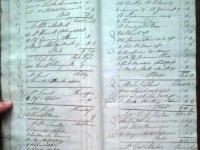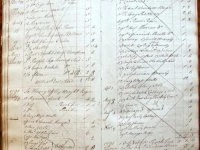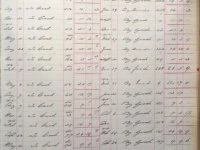Surviving Ledgers
Although only a few ledgers have survived, it is so unusual for any business ledgers to do so, that these have to be considered a really valuable resource. The originals are held at the Cheshire Record Office http://archives.cheshire.gov.uk/, but the oldest ones are now extremely fragile. Some have suffered water damage, which makes them difficult to read.
All the ledgers have been photographed, and can be found under Ledger Transcriptions, although not all the ledgers have yet been (or will be) transcribed. The ledgers which date from the 1790s are from both the Knowsley and Knutsford nurseries, while the others relate only to Knutsford. They also vary in the use to which they were put. The different uses are explained here.

This was used to record sales as they happened at the nursery. This means that they are in date order, and also that many of the sales are for only a few items. Sometimes customers would pay cash and at other times their purchases would be added to their account.
Surviving Day Book Ledgers Accession numbers DDX 363/2; DDX 363/3; DDX 363/7; DDX 363/8; DDX 363/9; DDX 363/10

This was used to record the orders placed by customers. All the ledgers are hard-bound (loose-leaf ledgers would not appear for a long time). At the front there has to be a list of customers with the pages on which their orders can be found. This means that Order books (unlike Day Books) have page numbers. Once the first page allotted to a customer was filled up, the total would be carried forward to the next free page. Some customers ordered a great deal and they ended up with many pages allotted to them. The total value of a sale on credit recorded in the Day Book would be transferred to the Order Book. Every so often the nurseryman would write out an invoice and record this (and when the bill was paid). In the Order Book, you will notice that completed orders have been crossed through. This would have signified that the order had been despatched.
You will also see that none of these early Books were lined – which means that it can sometimes be difficult to know which price goes with which item. You will see that the writer has put in a dotted line between the order and the price to help with this.
Surviving Order Book Ledgers Accession number DDX 363/6

Totals from the Order Book were transferred into the Sales Ledger which recorded how much was owed by each customer. There would usually be a list of dates with the totals ordered on those dates and then the amount paid. Sales books therefore do not give us a great deal of information about plants sold (although sometimes they are listed), but can tell us which customers settled their accounts more quickly than others.
Surviving Sales Book Ledgers Accession numbers DDX 363/1; DDX 363/4

Like the Sales Ledger, the Purchase Ledger simply lists out "Goods" with the value of each order and shows when accounts were settled and whether any discount was taken. Although we don't know what Caldwell's was being supplied with, we will be trying to find out what business their suppliers were in.
Surviving Purchase Ledger. 1912 – 1926 Accession number DDX 363/5

The cash book records money going into and out of a business. At the end of the year if more money has been taken in than has been paid out, the business is in profit. There are a number of cash books. At the end of the financial year (September 25), the partners recorded how they split their profits and signed off the accounts.
Surviving Cash Book Ledgers Accession numbers DDX 363/7 (back of the ledger only); DDX 363/11; DDX 363/12; DDX 363/13
There is one Wages Book which runs from 26 April 1844 to 27 September 1852. Each page is for a four week period, and attendance is recorded on each day by a single stroke. If only half a day was worked, this was shown by a half-stroke. Following each week, the book records the amount earned in that week – a full week would mean 11s. The totals for each week are listed at the bottom of the page and the total for the four weeks can be found in the Cash Book for the period.
Surviving Wages Book Ledger Accession number DDX 363/14
Further details of each of the surviving ledgers can be found in the attached document, and a full photographic record of all ledgers can be found in the menu option Ledger Transcriptions.

